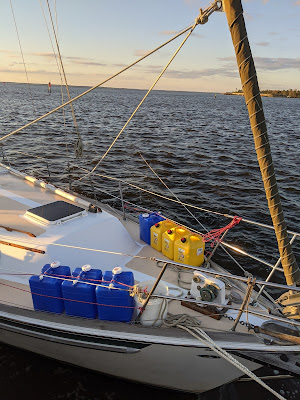 |
Mystery solved. That transmission was dead. Really, really dead.
With new and old transmissions set side-by-side the problem was clearly visible. A missing circlip had allowed the retaining nut to loosen, driving the shaft through the cover. No wonder the transmission was running dry. And fraying its cable. And working intermittently.
Which means all summer long, all the transmission-related things we fixed, they were all symptoms of this problem, and there was no way we could have known until it was separated from the engine. All of this drama was likely caused by the last service technician's lack of attention to a small but important 50 cent clip. Wish I knew who that guy was. I'd like to leave him a gift. From Chloe. It's already in a bag.
Well, deep breath. Onwards. The shiny new transmission hums along happily and the dead one is off to the knackers.
The two primary winches were also discovered to be dead. This was a bit of a surprise as we had them down as a Tier 3 project. We anticipated them to be like the first two we serviced, solved by simply breaking them down, scrubbing them well, and applying new grease. Alas they are frozen solid from years of neglect. So... new winches for us.
 |
| Winch #1 of 2 - we swapped our Lewmars for Andersens |
Covid part delays strike again: one winch showed up promptly and the other one is still on backorder.
 |
| Dead winch guts are beautiful in a steam punk sort of way |
Not to be deterred from our test-run mission, we temporarily shifted the jib sheets to the spinnaker winches for the transmission shakedown cruise. For the first time in 6 attempts, we left for a shakedown cruise and returned successfully. We motored. We anchored. We motored. We sailed. We motored again. We landed in the slip under our own power. What a glorious day! So long overdue!
What a relief!
This week the air conditioner finally gets installed (those parts were ordered in June... Covid delays again), and then the fuel system is being revised to give us greater control over the fuel/engine relationship. These two projects are beyond our scope and frankly we're ready to let someone else work on the boat for a while. We found a great mechanic to handle these two projects and the process will require total boat destructo. Better if we aren't underfoot.
 |
| Parking Loretta at the marina made moving back aboard easier |
So we moved back onto Loretta. This was the November plan all along, although we thought by now we'd have pictures and sailing stories to share from our grand NorthEast sailing tour. November's plan is to camp with friends in nearby New Bern, followed by Thanksgiving with dock neighbors, and then cruising Loretta to the Keys for December. The rough January sketch is to continue the road trip back to California to fetch our scuba and boat gear, check in with family and friends, doctors and dentists, other mandatory adulting. If the weather cooperates we'll take the bikes out for a mountaintop romp or two.
Oh. And tacos. We will definitely be stopping for New Mexico tacos along the way.
Look out America... two returning full-timers headed your way for another lap.



